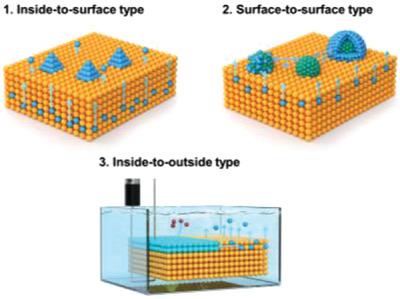当前位置:
X-MOL 学术
›
Adv. Mater.
›
论文详情
Our official English website, www.x-mol.net, welcomes your feedback! (Note: you will need to create a separate account there.)
Dynamic Surface Evolution of Metal Oxides for Autonomous Adaptation to Catalytic Reaction Environments
Advanced Materials ( IF 29.4 ) Pub Date : 2022-06-23 , DOI: 10.1002/adma.202203370 Jun Kyu Kim 1 , Sangwoo Kim 1 , Seunghyun Kim 1 , Hyung Jun Kim 2 , Kyeounghak Kim 3 , WooChul Jung 1 , Jeong Woo Han 2
Advanced Materials ( IF 29.4 ) Pub Date : 2022-06-23 , DOI: 10.1002/adma.202203370 Jun Kyu Kim 1 , Sangwoo Kim 1 , Seunghyun Kim 1 , Hyung Jun Kim 2 , Kyeounghak Kim 3 , WooChul Jung 1 , Jeong Woo Han 2
Affiliation

|
Metal oxides possessing distinctive physical/chemical properties due to different crystal structures and stoichiometries play a pivotal role in numerous current technologies, especially heterogeneous catalysis for production/conversion of high-valued chemicals and energy. To date, many researchers have investigated the effect of the structure and composition of these materials on their reactivity to various chemical and electrochemical reactions. However, metal oxide surfaces evolve from their initial form under dynamic reaction conditions due to the autonomous behaviors of the constituent atoms to adapt to the surrounding environment. Such nanoscale surface phenomena complicate reaction mechanisms and material properties, interrupting the clarification of the origin of functionality variations in reaction environments. In this review, the current findings on the spontaneous surface reorganization of metal oxides during reactions are categorized into three types: 1) the appearance of nano-sized second phase from oxides, 2) the (partial) encapsulation of oxide atoms toward supported metal surfaces, and 3) the oxide surface reconstruction with selective cation leaching in aqueous solution. Then their effects on each reaction are summarized in terms of activity and stability, providing novel insight for those who design metal-oxide-based catalytic materials.
中文翻译:

金属氧化物的动态表面演变以自主适应催化反应环境
由于不同的晶体结构和化学计量,金属氧化物具有独特的物理/化学性质,在许多当前技术中发挥着关键作用,特别是用于生产/转化高价值化学品和能源的多相催化。迄今为止,许多研究人员已经研究了这些材料的结构和组成对其对各种化学和电化学反应的反应性的影响。然而,由于组成原子适应周围环境的自主行为,金属氧化物表面在动态反应条件下从其初始形式演变而来。这种纳米级表面现象使反应机制和材料特性复杂化,中断了对反应环境中功能变化起源的澄清。在这篇评论中,目前关于金属氧化物在反应过程中自发表面重组的发现分为三种类型:1)氧化物纳米级第二相的出现,2)氧化物原子(部分)封装到支撑金属表面,以及 3)在水溶液中选择性阳离子浸出的氧化物表面重建。然后根据活性和稳定性总结了它们对每个反应的影响,为设计基于金属氧化物的催化材料的人员提供了新的见解。3) 通过在水溶液中选择性阳离子浸出来重建氧化物表面。然后根据活性和稳定性总结了它们对每个反应的影响,为设计基于金属氧化物的催化材料的人员提供了新的见解。3) 通过在水溶液中选择性阳离子浸出来重建氧化物表面。然后根据活性和稳定性总结了它们对每个反应的影响,为设计基于金属氧化物的催化材料的人员提供了新的见解。
更新日期:2022-06-23
中文翻译:

金属氧化物的动态表面演变以自主适应催化反应环境
由于不同的晶体结构和化学计量,金属氧化物具有独特的物理/化学性质,在许多当前技术中发挥着关键作用,特别是用于生产/转化高价值化学品和能源的多相催化。迄今为止,许多研究人员已经研究了这些材料的结构和组成对其对各种化学和电化学反应的反应性的影响。然而,由于组成原子适应周围环境的自主行为,金属氧化物表面在动态反应条件下从其初始形式演变而来。这种纳米级表面现象使反应机制和材料特性复杂化,中断了对反应环境中功能变化起源的澄清。在这篇评论中,目前关于金属氧化物在反应过程中自发表面重组的发现分为三种类型:1)氧化物纳米级第二相的出现,2)氧化物原子(部分)封装到支撑金属表面,以及 3)在水溶液中选择性阳离子浸出的氧化物表面重建。然后根据活性和稳定性总结了它们对每个反应的影响,为设计基于金属氧化物的催化材料的人员提供了新的见解。3) 通过在水溶液中选择性阳离子浸出来重建氧化物表面。然后根据活性和稳定性总结了它们对每个反应的影响,为设计基于金属氧化物的催化材料的人员提供了新的见解。3) 通过在水溶液中选择性阳离子浸出来重建氧化物表面。然后根据活性和稳定性总结了它们对每个反应的影响,为设计基于金属氧化物的催化材料的人员提供了新的见解。


























 京公网安备 11010802027423号
京公网安备 11010802027423号